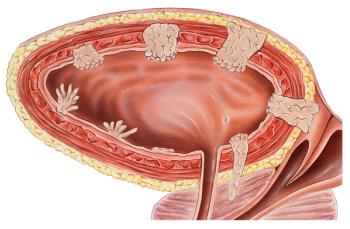
ASCO GU: Clinical Staging in Bladder Cancer Inaccurate Nearly Half of the Time
The use of presurgical characteristics to assign the clinical stage of a patient with bladder cancer was found to be highly inaccurate with a clinical/pathological stage discrepancy rate of 47.8% found in a large sample of patients taken from the National Cancer Data Base between 1998 and 2009.
ORLANDO, Fla.-The use of presurgical characteristics to assign the clinical stage of a patient with bladder cancer was found to be highly inaccurate, with a clinical/pathological stage discrepancy rate of 47.8% found in a large sample of patients taken from the National Cancer Data Base between 1998 and 2009.
“These data can provide an important context for physicians and researchers as they are making appropriate therapeutic decisions for their patients,” said Phillip J. Gray, MD, of the Harvard Radiation Oncology Program, during his
Although this is not the first time that a clinical trial has looked at clinical/pathologic staging discrepancies in bladder cancers, most prior analyses have included data from large academic centers, where therapies and outcomes are not necessarily representative of those of community-based cancer practices.
Gray and colleagues looked at staging information from 16,953 patients with bladder cancer who underwent radical cystectomy. They also conducted a survival analysis in 7,270 patients diagnosed between 1998 and 2004 for whom 5-year follow-up data were available. About 50% of patients came from large academic centers. About 20% of patients had nonmuscle invasive disease at diagnosis. Of those patients with muscle-invasive disease, the vast majority were diagnosed with clinical stage T2 disease, Gray said.
The overall clinical/pathological stage discrepancy rate of 47.8% included 41.9% of patients who were upstaged at the time of surgery and 5.9% of patients who were downstaged at the time of surgery.
Data examining T-stage discrepancies indicated that there was a high rate of upstaging in the early clinical stages, peaking in clinical stage T2 at 46.2%, Gray said. Patients with clinical stage T3 disease had approximately equal rates of upstaging and downstaging, about 10%.
Upstaging at the time of surgery was associated with an increased 5-year mortality (HR = 1.79; P < .0001). Downstaging was not linked with survival outcomes.
Upstaging of disease was more likely to occur in:
• Women (Odds ratio [OR] = 1.08; P = .038)
• Patients aged 80 years or older (OR = 1.26 vs patients aged 18 to 59; P = .001)
• Patients with higher tumor grade (OR = 2.29 for grade 3/4 vs grade 1; P < .0001)
• Patients with nonurothelial histology (OR = 1.31; P = .002 for squamous and OR = 1.26; P = .03 for adenocarcinoma)
• Patients with extended lymphadenectomy (OR = 1.27 for 10 or more lymph nodes examined vs 0 to 9; P < .0001)
Downstaging of patients was less common in patients aged older than 80 years, Hispanics, and those with variant histology. However, patients who received neoadjuvant chemotherapy had a 2.31 OR for downstaging of disease (P < .0001).
Dean F. Bajorin, MD, of Memorial Sloan-Kettering Cancer Center, pointed out that researchers have always known that there were discrepancies between clinical and pathological staging in bladder cancer, but that this highly robust and definitive study confirms that clinical staging is “highly inaccurate.”
“Forty-two percent of patients are understaged and 46% of T2s are upstaged,” Bajorin said. “The impact of this study is that we simply cannot compare overall survival in surgical and nonsurgical series.”
Newsletter
Stay up to date on recent advances in the multidisciplinary approach to cancer.

























































































